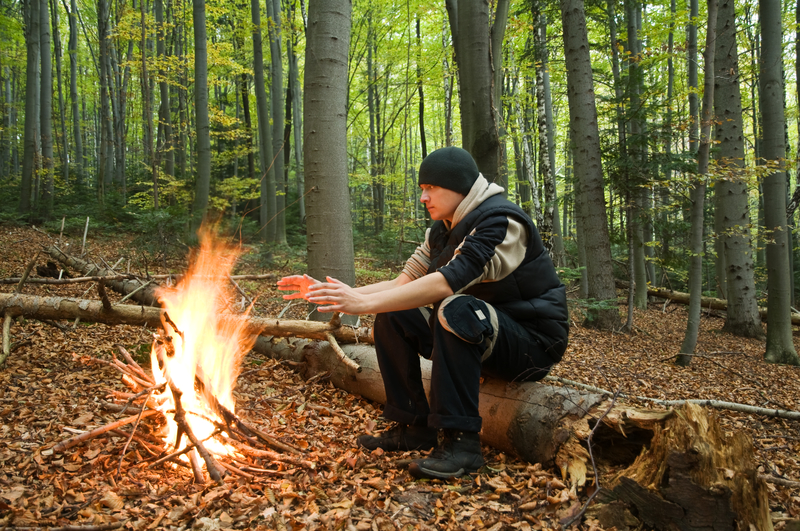Just as the technology for phones, cars and homes has transformed over the years, the same has occurred with fire craft. You won't need to sit in the woods for hours hoping and praying that your fire will spark using the sticks around you. While the ultimate survivalist would be able to successfully start a fire with all of these methods, they each have advantages and disadvantages. If one way doesn't work for you, then you can always move on to the next one!
The Ferrocerium Rod
The ferrocerium rod is at the heart of most bushmen’s and survivalist’s fire starting kit. The rod itself is made up of a mix of iron, cerium, lanthanum, neodymium and magnesium.
A common issue is the grip or handle, coming off of the rod. You can fix this with a strong glue around the grip socket.
If you are improperly striking you rod you will find it getting grooves and dents along it. To remove these you will have to adjust your grip and the angle in which you strike it.
You can use a simple layer of spray paint to cover the rod and prevent further damage.
The rod requires a striker or knife to make a spark. If you lose that you are in trouble. However, there are some one-handed models on the market that will eliminate this problem.
The Magnesium Block
The magnesium block works as both source of ignition and tinder all in one. This piece of kit has all the advantages of the ferrocerium rod and does not have the disadvantage of the grip issue. By using the striker or a knife to grind off small slithers of magnesium from the main block into a small pile, you create an extremely flammable and ready for use tinder source. These shavings can be used as they are or to enhance an already existing tinder bundle or birds nest.
To get the most out of your block keep it well oiled, shave it carefully and keep it in your pack or pocket to avoid unwanted chipping of the block.
The Spark Wheel
Simply put the spark wheel is a lighter without the gas. It is small, light weight and able to create a spark strong enough to light fine tinder. The main advantage is the size, weight and the ability to work without a striker. The downside here is the need to replace the flint inside. However, in this modern age flints can be found everywhere. A discarded lighter will act as a spark wheel in a cinch.
The Fire Piston
The fire piston or fire syringe as it is also called has been around for longer than all of the previously discussed methods of making fire. It works around a basic principle. When air is compressed under high pressure it raises in temperature very fast, causing the tinder at the end of the rod to ignite. The internal heat of the rod gets up to around 500 degrees Fahrenheit.
Modern pistons are made of steel, aluminum, bass or even plastic. Rubber o-rings make the seal and modern materials such as cotton or char cloth are used for tinder.
The big advantage of the piston is that the outside conditions play less of a factor. The o-ring must be lubricated and if you do not push down as a straight angle the rod may bend or break, making the piston useless. Also, it does require very small and highly combustible tinder. The tinder that you can light with a ferrocerium rod may not light with a piston.
The Magnifying Glass / Sun Glass
It can take minutes to hours to ignite even the best tinder via this method. The lens should be at least X5 magnification and at large as is practical for you. The biggest draw back is the dependency on the weather. To create enough concentrated sunlight to cause ignition you will need a highly polished surface or a decent, clean lens to focus the light. The light itself must also be consistent and focused on a single point. A clear container filled with water can also achieve fire if the same principles are applied.
Other Modern Methods
Fire example a battery and some wire wool or aluminum foil. However, these methods are usually only suited to work once or twice before they are done.
So when it comes down to it what is the best tool for the job?
I find the combination of the Swedish Ferrocerium rod, due to its superior grip and striker and a separate magnesium block to be a winning combination. The reason for this is that the issue of the surface area of the blocks rod is solved via the addition of a second rod. This setup gives you two ready sources of ignition and a tinder source that is not water sensitive.
Tips and Tricks
- When using a rod or magnesium block, pull the rod towards you while keeping the striker stationary. This will prevent you from accidentally hitting and destroying your tinder bundle or heap or shavings and allow you more control when directing the sparks.
- Use Vaseline as a lubricant for your fire piston.
- Keep your arm (which ever is used to hold the bearing block or socket, not the bow) pinned to your knee or shin when attempting the bow drill. This will give you more stability and a more controlled spin on the drill. Also, don’t make the mistake of going to fast too soon. If you do you will generate a lot of heat without having ground off the wood fibres needed to create the coal.
- Making a solar fire is easiest between the hour of 10am and 2pm and will always be easier in the summer rather than the winter.
Have you been able to build a fire using any of these methods? Let us know!
Article Source: The Prepper Journal
